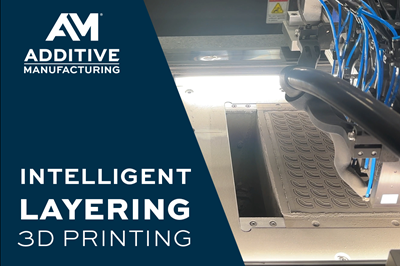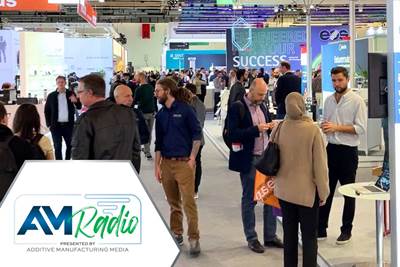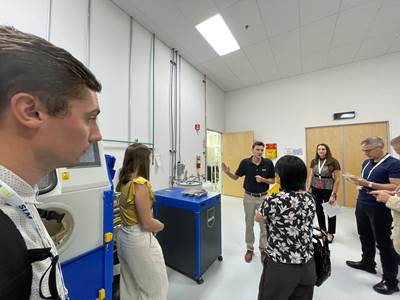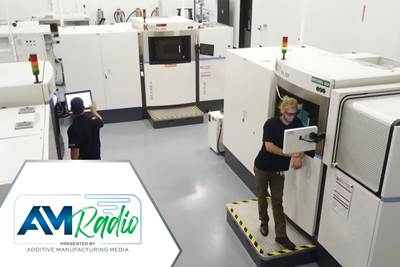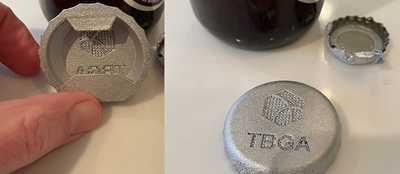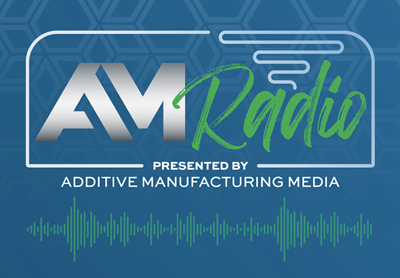3D Printing for Production at Scale
Additive manufacturing for production employs the use of 3D printing to make end-use functional components at production repeatability and scale. “3D printing” describes an entire group of part making processes that generally build components layer by layer using an ever-growing variety of materials. Additive manufacturing is often implemented as a bridge production solution for a new product before it moves to a more conventional method, but is increasingly being applied as the sole manufacturing method for full-scale production.

ESSENTIAL READING
VIEW ALLVideo: Intelligent Layering Metal 3D Printing at 3DEO
Contract manufacturer 3DEO delivers metal parts using Intelligent Layering, a binder jetting-like 3D printing process the company developed and operates internally. Here’s how it works.
WatchCopper, New Metal Printing Processes, Upgrades Based on Software and More from Formnext 2023: AM Radio #46
Formnext 2023 showed that additive manufacturing may be maturing, but it is certainly not stagnant. In this episode, we dive into observations around technology enhancements, new processes and materials, robots, sustainability and more trends from the show.
ListenThe AM Ecosystem, User Journeys and More from Formnext Forum Austin: AM Radio #43
Sessions and conversations at the first U.S. Formnext event highlighted the complete additive manufacturing ecosystem, sustainability, the importance of customer education, AM user journeys and much more.
ListenHow to Organize for Additive Production: AM Radio #42
Tim Simpson and Peter Zelinski discuss the next steps for succeeding with AM: After technical and process successes come the cultural, organizational and even costing considerations associated with this mode of manufacturing.
ListenA Framework for Qualifying Additively Manufactured Parts
A framework developed by The Barnes Global Advisors illustrates considerations and steps for qualifying additively manufactured parts, using an example familiar to those in AM: the 3D printed bottle opener.
Read MoreThe New Misperceptions Of AM: AM Radio #35
Tim Simpson and Peter Zelinski discuss a way additive manufacturing has advanced: The misperceptions have shifted. Knowledge of AM among manufacturers is more sophisticated now. The concerns that inform the perceptions of newcomers have therefore changed.
ListenLatest Production News And Updates
Endeavor 3D, CADmore Collaborate to Strengthen AM Foothold in Southeast US
Endeavor 3D and CADmore will work together to push forward new advancements in the additive design and manufacturing industry.
Read MoreLithoz CeraFab System S320 LCM Printer Designed for Efficient, High-Capacity Industrial Serial Production
Formnext 2024: The system offers a build speed of up to 150 layers per hour and layer thickness of 20–200 µm.
Read MoreBaker Hughes Successfully Implements Oqton Manufacturing OS System to Optimize Additive-Driven Manufacturing Workflow
3D Systems say this successful implementation demonstrates its Oqton Manufacturing OS’ ability to accelerate the design and production of additively manufactured parts across the entire manufacturing workflow to increase efficiency and facilitate regulatory compliance.
Read MoreHitachi Rail Uses Roboze Technology to Produce Spare Parts
Using Roboze’s ARGO 500 3D printer enables Hitachi Rail to implement industrial 3D printing technology, using materials such as Ultem 9085 and Carbon PEEK for the production of spare parts for its trains.
Read MoreMassive Dimension Becomes Authorized Integrator for FANUC Robots
Massive Dimension can now integrate FANUC’s robotics technology to enhance its additive manufacturing offerings, enabling more customized solutions tailored to specific customer requirements — from prototyping to full-scale production.
Read More3D Systems’ PSLA 270 Creates Midsize, Production-Grade Parts Combining SLA Print Reliability
IMTS 2024: The PSLA 270 is engineered to deliver larger end-use parts more rapidly than similar platforms, bringing tremendous advantages for a breadth of industrial and health care applications.
Read MoreFeatured Posts
Two 12-Laser AM Machines at Collins Aerospace: Here Is How They Are Being Used
With this additive manufacturing capacity, one room of the Collins Iowa facility performs the work previously requiring a supply chain. Production yield will nearly double, and lead times will be more than 80% shorter.
Read MoreVideo Tour: Collins Aerospace AM Production Site in West Des Moines
The 12-laser powder bed fusion machines are at the heart of the company’s new production capacity for aircraft engine parts in both aluminum and nickel-based alloy.
Watch8 Cool Parts From Formnext 2024: The Cool Parts Show #78
End-use parts found at Formnext this year address various aspects of additive's advance, notably AM winning on cost against established processes.
WatchFeatured Media
3D Printing Enables a Larger "Sweet Spot" Relative to This Golf Club's Size: The Cool Parts Show #77
Cobra Puma Golf's Limit3D iron uses 3D printed stainless lattices to remove weight from the interior so that it can be reintroduced with tungsten inserts that lower the center of gravity. The combination offers a smaller, sleeker club head with the forgiveness of a larger one.
Watch3D Printed Capo for Banjo Made With Binder Jetting not MIM: The Cool Parts Show #74
New market, no mold tooling needed: Additive manufacturing via binder jetting enables a maker of guitar capos to expand to serve banjo players as well.
WatchVideo: 5" Diameter Navy Artillery Rounds Made Through Robot Directed Energy Deposition (DED) Instead of Forging
Big Metal Additive conceives additive manufacturing production factory making hundreds of Navy projectile housings per day.
WatchFAQ: Production
What is bridge production?
“Bridge production” refers to the initial, lower-quantity production of a new product or part that the manufacturer performs quickly. That is, production carried out now: before the tooling is produced, before the final process is engineered, before the part or product design is even finalized. It bridges the production gap between concept and creation.
Are 3D printing and additive manufacturing the same thing?
Some say yes and we say no! AM and 3D printing are overlapping terms but not synonyms. 3D printing is the operation at the heart of additive manufacturing, just as “turning” or “molding” might be the operation at the heart of a conventional manufacturing process.
In a nutshell, 3D printing is one step in an overall additive manufacturing workflow that also includes design, build preparation, postprocessing, business considerations and more.
Importantly, “3D printing” does not describe just one type of technology. Per ISO/ASTM, there are seven different “families” of 3D printing processes, and a growing number of material and machine options.
When is additive manufacturing the best production choice?
Additive manufacturing has been shown to be a good option in numerous production applications. These includes instances where:
- A product is designed with a complex geometric makeup, especially internally, that often consolidates multiple parts into one AM produced part.
- Low volumes are produced, typically for niche products, though the quantities appropriate for 3D printing continue to increase.
- Goods must be personalized or customizable.
- Items need to be manufactured locally.
- Investing in conventional equipment is a barrier.
What are the different types of additive manufacturing?
Additive manufacturing has been categorized by ASTM F2792 Standards into the 7 Families of Additive Manufacturing. They are:
- VAT photopolymerization
- Powder bed fusion (PBF)
- Binder jetting
- Material jetting
- Sheet lamination
- Material extrusion
- Directed energy deposition and hybrid manufacturing
Source: 3D Printing Processes
What do you need to be ready for additive manufacturing production?
1. Multiple materials
2. Multiple platforms
3. Location near customers
4. Postprocessing and finishing capability
5. Open machine capacity
6. Agility
Source: What Does Additive Manufacturing Readiness Look Like?
How does additive manufacturing benefit serial production?
Unlike a typical serial production job where parts are made identically every time, additive as the production technology allow the customer to continue to iterate even as products are put into testing and into the market.
As described in this article, a production run of bezels for automotive sensors, for instance, saw the same number of design iterations within a much smaller quantity.
“Within 500 parts that we printed, they made three changes,” says Kyle Harvey, business unit manager for additive manufacturing at Extol. This is not just additive manufacturing taking over production; it is a different kind of production all together.



